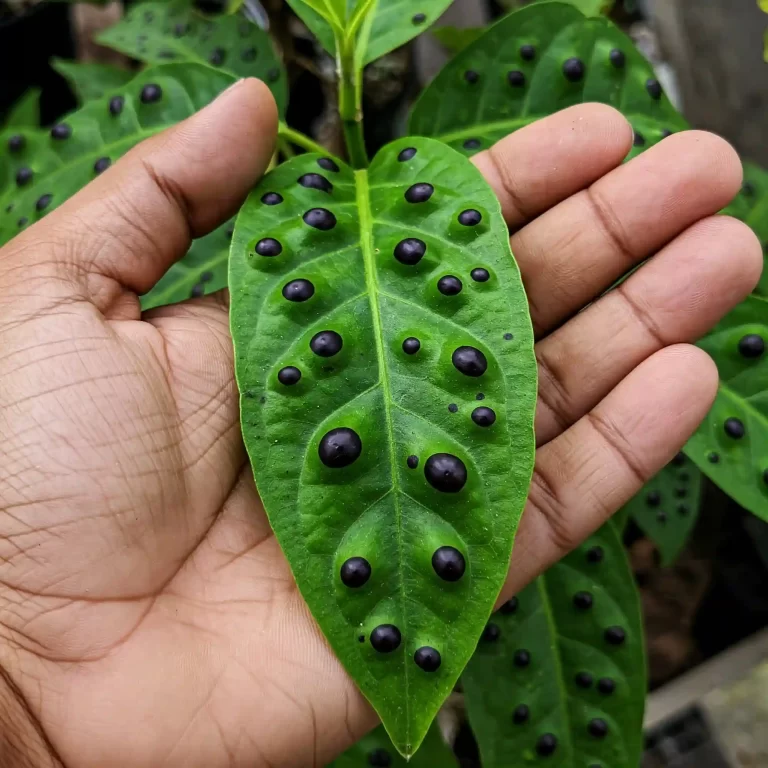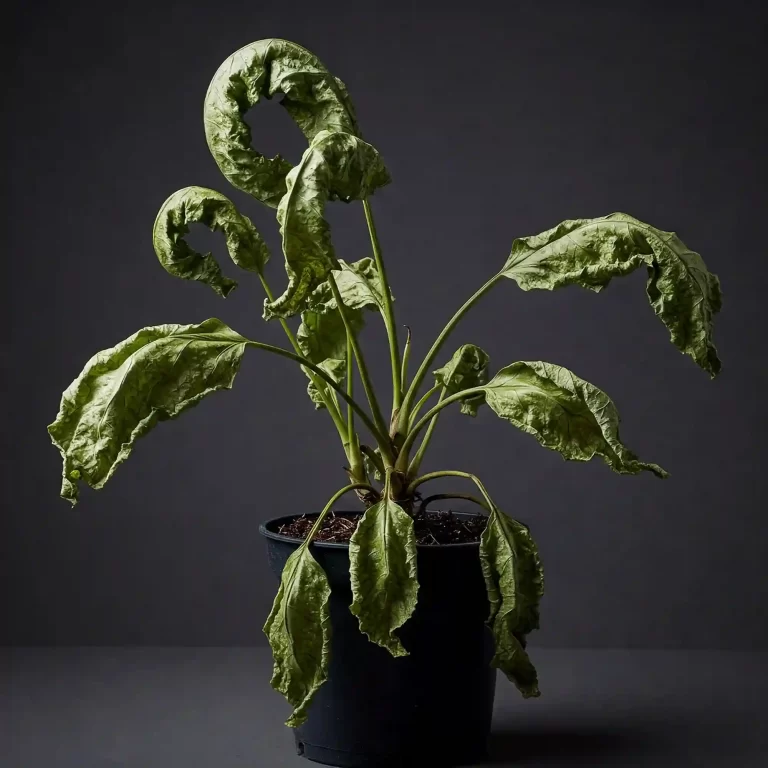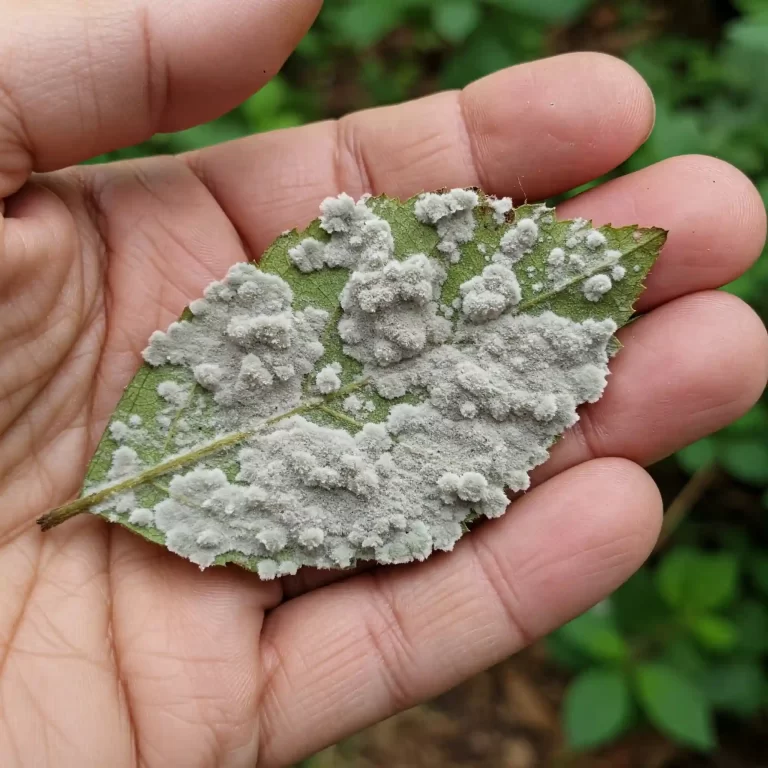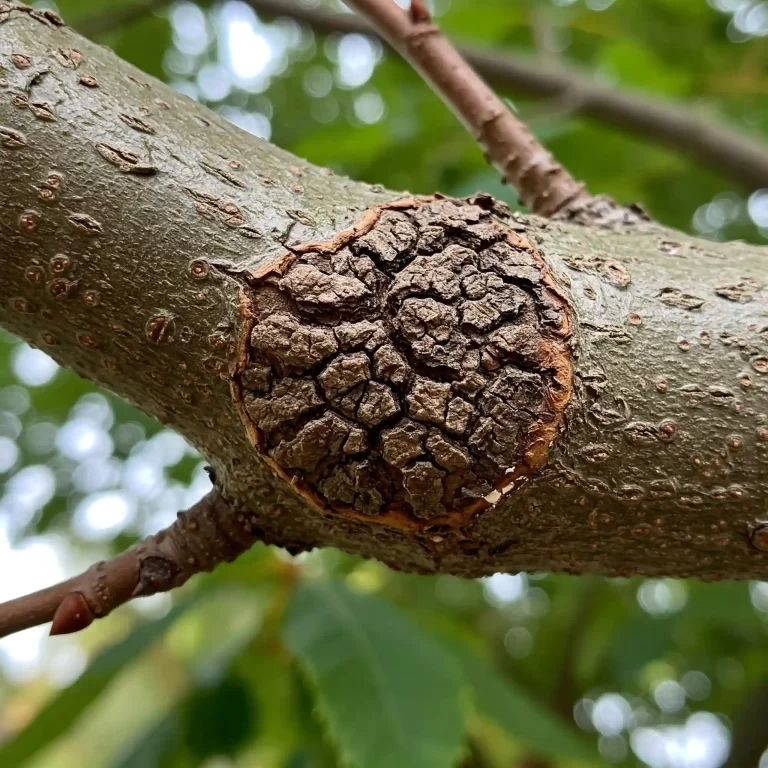| Pilea dark mystery is a beautiful and exotic houseplant with dark green leaves that have a chocolate brown tinge and silvery stripes up the center. |
| It is also known as pilea involucrata, pilea hitchcockii, or lizard tail pilea. It is native to the rainforest of Ecuador and likes warm and humid conditions. |
| It prefers well-draining, all-purpose potting soil that has added organic matter and perlite. It also likes slightly acidic to neutral PH level (6.0 to 7.0). |
| It needs bright indirect light for up to 8 hours per day. Avoid direct sunlight as it can scorch the leaves. |
| It requires water when the top inch of soil feels dry to the touch. Do not let the soil dry out completely or the plant will droop dramatically. Do not overwater or the roots may rot. |
| It thrives in a warm and consistent temperature range between 62°F to 85°F (16°C to 29°C). It is not suited for colder climates. |
| It enjoys high and constant humidity level between 60% to 80%. You can mist the plant regularly, place it on a pebble tray with water, or use a humidifier. You can also grow it in a terrarium. |
| It benefits from balanced liquid fertilizer diluted to half strength once a month during the growing season. Do not fertilize in winter. |
| It needs pruning in spring or summer to encourage new growth and shape the plant. Prune the growth tips, the lower leaves, and any damaged, dying, or diseased leaves. |
| It can reward you with small pink flowers that appear above the foliage. It is a pet-safe plant and not considered toxic to cats, dogs, or people. |
Have you ever seen a houseplant that looks like it has lizard tails? Or maybe you have noticed a plant that has dark green leaves with a chocolate brown tinge and silvery stripes up the center? If you have, then you have probably encountered pilea dark mystery, a stunning and exotic houseplant that will add a touch of mystery and beauty to your home.
Pilea dark mystery is a member of the nettle family and has the scientific name of pilea involucrata. It is also known as pilea hitchcockii or lizard tail pilea. It is native to the rainforest of Ecuador, where it grows in the understory of the forest. It is a rare and hard-to-find plant that is not widely available in nurseries or garden centers. However, you may be able to find it online or from specialty growers.
Pilea dark mystery is a low-maintenance and easy-to-care-for plant that can grow up to 12 inches tall and wide. It has triangular leaves with serrated edges that are dark green with a chocolate brown tinge. The leaves have silvery stripes up the center that give them a metallic sheen. The leaves also point in different directions, creating a flame-like appearance. The plant can produce small pink flowers that emerge above the foliage, adding more charm and color to the plant.
In this article, we will show you how to care for pilea dark mystery and make it thrive in your home. We will cover the soil, light, water, temperature, humidity, fertilizer, and pruning requirements of this plant. We will also provide some tips and tricks to help you avoid common problems and enjoy this plant for a long time. By the end of this article, you will be able to grow pilea dark mystery like a pro and impress your friends and family with your exotic and stunning houseplant.
Soil
Soil is one of the most important factors for pilea dark mystery, as it affects the health and growth of the plant. Pilea dark mystery prefers well-draining, all-purpose potting soil that has added organic matter and perlite. You can also use a soil mix for African violets, which is similar to the soil mix for pilea dark mystery.
The organic matter in the soil mix provides nutrients and moisture for the plant, while the perlite improves the drainage and aeration of the soil. Pilea dark mystery does not like heavy, compacted, or soggy soil, as it can cause root rot and fungal infections. Therefore, you should use a pot with drainage holes and avoid overwatering the plant.
Another factor to consider is the PH level of the soil, which is a measure of how acidic or alkaline the soil is. Pilea dark mystery likes slightly acidic to neutral soil, with a PH level between 6.0 to 7.0. You can test the PH level of your soil using a PH kit or a PH meter, which are available in most garden centers or online. If your soil is too acidic or too alkaline, you can adjust it using natural amendments, such as vinegar, lemon juice, baking soda, or wood ash.
Here are some tips and warnings for choosing and preparing the soil for pilea dark mystery:
- Sterilize the soil before planting to kill any harmful bacteria, fungi, or pests. You can do this by baking the soil in an oven at 180°F (82°C) for 30 minutes, or by microwaving the soil in a microwave-safe container for 10 minutes.
- Repot the plant every year or two to refresh the soil and prevent root bound. Choose a pot that is slightly larger than the previous one and has drainage holes. Fill the pot with fresh soil mix and gently transfer the plant to the new pot. Water the plant well and place it in a bright spot.
- Do not use soil from your garden or yard, as it may contain weeds, pests, or diseases that can harm your plant. Use only sterile, commercial, or homemade potting soil for pilea dark mystery.
Light
Light is another crucial factor for pilea dark mystery, as it affects the color and shape of the leaves. Pilea dark mystery needs bright indirect light for up to 8 hours per day. Avoid direct sunlight as it can scorch the leaves and cause them to fade, yellow, brown, or crispy.
The best location for pilea dark mystery is near a window that faces east, west, or south. These windows provide enough light for the plant without exposing it to harsh sun rays. You can also use a sheer curtain, a shade cloth, or a grow light to filter or supplement the light for pilea dark mystery.
If your plant does not get enough light, it may become leggy, droopy, or pale. The leaves may also lose their chocolate brown tinge and silvery stripes, making them less attractive. To prevent this, you should move your plant to a brighter spot or use a grow light to increase the light intensity and duration.
Here are some tips and warnings for adjusting and monitoring the light for pilea dark mystery:
- Rotate the plant regularly to ensure even growth and prevent leaning. Pilea dark mystery tends to grow towards the light source, so you should turn the pot every week or two to keep the plant balanced and symmetrical.
- Move the plant away from heat sources or cold drafts, such as radiators, fireplaces, air conditioners, or fans. These can affect the temperature and humidity around the plant and cause stress or damage to the plant.
- Check the light intensity and duration with a light meter or an app, such as Lux Meter or Plant Light Meter. These tools can help you measure how much light your plant is getting and whether it is enough or not. You can also use your hand to test the light: if you see a sharp shadow, the light is too strong; if you see a faint shadow, the light is adequate; if you see no shadow, the light is too weak.
Water
Water is another vital factor for pilea dark mystery, as it affects the moisture and hydration of the plant. Pilea dark mystery requires water when the top inch of soil feels dry to the touch. Do not let the soil dry out completely or the plant will droop dramatically. Do not overwater or the roots may rot.
The best way to water pilea dark mystery is to use room temperature, filtered, or rain water. Avoid tap water as it may contain chlorine, fluoride, or salts that can harm the plant. Water the plant thoroughly until the water drains out of the bottom of the pot. Discard any excess water in the saucer to prevent soggy soil.
The frequency of watering pilea dark mystery depends on the season, temperature, and humidity. In summer, you may need to water the plant more often, as the soil dries out faster. In winter, you may need to water the plant less often, as the soil stays moist longer. You should always check the soil moisture before watering the plant and adjust accordingly.
Here are some signs of overwatering or underwatering pilea dark mystery:
- Overwatering: wilted, yellow, or mushy leaves; soft, brown, or rotten roots; mold, fungus, or gnats on the soil or the plant.
- Underwatering: curled, brown, or brittle leaves; dry, shriveled, or hard roots; drooping, wilting, or falling leaves.
Here are some tips and warnings for regulating and measuring the water for pilea dark mystery:
- Use a moisture meter or a wooden skewer to check the soil moisture. A moisture meter is a device that has a probe that you insert into the – soil and insert it into the soil. The device will show you a reading of how wet or dry the soil is. A wooden skewer is a simple tool that you can use to poke the soil and pull it out. If the skewer comes out clean, the soil is dry; if the skewer comes out wet, the soil is moist.
- Mist the leaves occasionally to remove dust and pests. Pilea dark mystery has hairy leaves that can collect dust and attract spider mites, mealybugs, or scale insects. To prevent this, you can mist the leaves with water or a mild soap solution once a week or as needed. This will also increase the humidity around the plant and keep it happy and healthy.
- Do not water the plant from above, as it can cause water to accumulate in the center of the plant and cause rot or fungal infections. Instead, water the plant from the side or the bottom, using a watering can or a saucer. This will ensure that the water reaches the roots and not the leaves.
Temperature
Temperature is another essential factor for pilea dark mystery, as it affects the metabolism and growth of the plant. Pilea dark mystery thrives in a warm and consistent temperature range between 62°F to 85°F (16°C to 29°C). It is not suited for colder climates, as it can suffer from frost damage or dormancy.
The best place to keep pilea dark mystery is indoors, in a room that has stable and moderate temperature. You can also grow it outdoors in regions that have tropical or subtropical climate, but bring it inside when the temperature drops below 50°F (10°C). Pilea dark mystery does not tolerate extreme temperature fluctuations, so you should avoid placing it near heat sources or cold drafts, such as radiators, fireplaces, air conditioners, or fans.
Here are some signs of too high or too low temperature for pilea dark mystery:
- Too high temperature: drooping, wilting, or discoloring leaves; reduced flowering; increased pest infestation; increased water loss; reduced growth.
- Too low temperature: curling, shriveling, or falling leaves; brown or black spots on the leaves; reduced flowering; reduced water uptake; reduced growth.
Here are some tips and warnings for maintaining and controlling the temperature for pilea dark mystery:
- Use a thermometer or a thermostat to monitor and regulate the temperature in your home or garden. These devices can help you keep track of the temperature and adjust it accordingly. You can also use an app, such as Smart Thermometer or Thermostat, to control the temperature remotely.
- Acclimate the plant gradually to any temperature changes, especially when moving it from indoors to outdoors or vice versa. Pilea dark mystery can get stressed or shocked by sudden temperature changes, which can affect its health and appearance. To prevent this, you should move the plant slowly and incrementally, exposing it to the new temperature for a few hours at a time, until it gets used to it.
- Protect the plant from frost or snow, if you live in a cold area. Pilea dark mystery can die or go dormant if exposed to freezing temperatures, so you should cover the plant with a cloth, a plastic bag, or a frost blanket, or bring it inside, if the temperature falls below 32°F (0°C).
Humidity
Humidity is another important factor for pilea dark mystery, as it affects the transpiration and photosynthesis of the plant. Pilea dark mystery enjoys high and constant humidity level between 60% to 80%. It is native to the rainforest of Ecuador, where it grows in the understory of the forest. It loves warm and humid conditions, which mimic its natural habitat.
The best ways to increase the humidity around pilea dark mystery are to mist the plant regularly, place it on a pebble tray with water, or use a humidifier. You can also grow it in a terrarium with other humidity-loving plants, such as ferns, orchids, or bromeliads. These methods can help you create a humid microclimate for your plant and keep it hydrated and happy.
Here are some signs of too low or too high humidity for pilea dark mystery:
- Too low humidity: dry, brown, or crispy leaf edges; reduced flowering; increased pest infestation; increased water loss; reduced growth.
- Too high humidity: mold, fungus, or pests on the soil or the plant; reduced flowering; reduced water uptake; reduced growth.
Here are some tips and warnings for enhancing and checking the humidity for pilea dark mystery:
- Avoid placing the plant near dry air sources or vents, such as heaters, dehumidifiers, or fans. These can lower the humidity around the plant and cause it to dry out or wilt.
- Use a hygrometer or a humidity gauge to measure the humidity in your home or garden. These devices can help you determine how humid your environment is and whether you need to increase or decrease it. You can also use an app, such as Humidity Meter or Humidity Monitor, to check the humidity remotely.
- Clean the leaves with a damp cloth to prevent dust and diseases. Pilea dark mystery has hairy leaves that can collect dust and harbor fungus or bacteria. To prevent this, you can wipe the leaves with a damp cloth or a mild soap solution once a week or as needed. This will also increase the humidity around the plant and keep it clean and healthy.
Fertilizer
Fertilizer is another beneficial factor for pilea dark mystery, as it affects the nutrition and flowering of the plant. Pilea dark mystery benefits from balanced liquid fertilizer diluted to half strength once a month during the growing season. Do not fertilize in winter, as the plant goes into a dormant or semi-dormant state and does not need extra nutrients.
The best way to apply fertilizer to pilea dark mystery is to water the plant before fertilizing to prevent root burn. Then, follow the instructions on the fertilizer label and pour the fertilizer solution evenly over the soil. Flush the soil with water every few months to remove any salt buildup that can harm the plant.
Here are some signs of too much or too little fertilizer for pilea dark mystery:
- Too much fertilizer: stunted, distorted, or burned leaves; reduced flowering; increased pest infestation; increased water loss; reduced growth.
- Too little fertilizer: slow, weak, or pale growth; reduced flowering; increased pest infestation; increased water uptake; reduced growth.
Here are some tips and warnings for choosing and using fertilizer for pilea dark mystery:
- Avoid synthetic, chemical, or high-nitrogen fertilizers, as they can damage the plant and cause it to grow too fast or too tall. Use organic, natural, or slow-release fertilizers, as they are safer and more gentle for the plant and the environment.
- Stop fertilizing if the plant shows signs of stress or disease, such as wilting, yellowing, or dropping leaves. Fertilizing a sick plant can worsen its condition and delay its recovery. Resume fertilizing when the plant recovers and resumes normal growth.
- Do not fertilize the plant when it is blooming, as it can reduce the quality and quantity of the flowers. Fertilizing a blooming plant can divert the energy and resources from the flowers to the leaves, making the flowers smaller, fewer, or shorter-lived. Wait until the blooming period is over before fertilizing the plant again.
Pruning
Pruning is another helpful factor for pilea dark mystery, as it affects the shape and health of the plant. Pilea dark mystery needs pruning in spring or summer to encourage new growth and shape the plant. Pruning can also stimulate flowering, increase branching, and prevent legginess.
The best time and method for pruning pilea dark mystery are to prune in spring or summer, when the plant is actively growing and can heal faster. Use sharp, clean, and sterilized scissors or pruners to cut the stems just above a leaf node, which is where a new leaf or branch can grow.
The best parts to prune on pilea dark mystery are the growth tips, the lower leaves, and any damaged, dying, or diseased leaves. Pruning the growth tips can make the plant bushier and wider, as it will produce more branches and leaves. Pruning the lower leaves can expose the stems and create a tree-like appearance, as well as improve the air circulation and light penetration around the plant. Pruning any damaged, dying, or diseased leaves can improve the plant’s health and appearance, as well as prevent the spread of pests and diseases.
Here are some benefits and drawbacks of pruning pilea dark mystery:
- Benefits: pruning can stimulate flowering, increase branching, and prevent legginess; pruning can also improve the plant’s health and appearance, as well as prevent the spread of pests and diseases.
- Drawbacks: pruning can cause stress, shock, or infection if done too much, too often, or too harshly; pruning can also reduce the size and shape of the plant, as well as the number and quality of the flowers.
Here are some tips and warnings for pruning and disposing pilea dark mystery:
- Prune lightly and gradually to avoid over-pruning. Pilea dark mystery does not need a lot of pruning, as it is a slow-growing and compact plant. You should only prune the plant to maintain its shape and health, not to change it drastically. You should also prune the plant in stages, removing a few stems or leaves at a time, rather than all at once.
- Prune in the morning or evening to avoid sunburn. Pilea dark mystery is sensitive to direct sunlight, especially after pruning, as the exposed stems and leaves can get burned by the sun. To prevent this, you should prune the plant in the morning or evening, when the sun is not too strong. You should also move the plant to a shaded spot or cover it – with a cloth or a plastic bag for a few days until the plant heals.
- Dispose of the pruned parts properly to prevent pests and diseases. Pilea dark mystery can attract spider mites, mealybugs, or scale insects, which can feed on the sap and weaken the plant. To prevent this, you should throw away the pruned parts in a sealed bag or a compost bin, or burn them if possible. Do not leave them on the soil or near the plant, as they can harbor pests and diseases.
Conclusion
Pilea dark mystery is a beautiful and exotic houseplant that will add a touch of mystery and beauty to your home. It has dark green leaves with a chocolate brown tinge and silvery stripes up the center, which give it a stunning and unique appearance. It can also produce small pink flowers that emerge above the foliage, adding more charm and color to the plant.
To care for pilea dark mystery, you need to provide it with well-draining, all-purpose potting soil that has added organic matter and perlite. You also need to give it bright indirect light for up to 8 hours per day, and water it when the top inch of soil feels dry to the touch. You need to keep it in a warm and consistent temperature range between 62°F to 85°F (16°C to 29°C), and increase the humidity around it by misting it regularly, placing it on a pebble tray with water, or using a humidifier. You need to feed it with balanced liquid fertilizer diluted to half strength once a month during the growing season, and prune it in spring or summer to encourage new growth and shape the plant.
Pilea dark mystery is a low-maintenance and easy-to-care-for plant that can grow up to 12 inches tall and wide. It is a pet-safe plant and not considered toxic to cats, dogs, or people. However, you should still keep it away from your pets so they don’t damage it. Pilea dark mystery is a rare and hard-to-find plant that is not widely available in nurseries or garden centers. However, you may be able to find it online or from specialty growers.
If you are looking for a houseplant that is exotic, stunning, and easy to care for, then pilea dark mystery is the perfect choice for you. It will add a touch of mystery and beauty to your home and impress your friends and family with your exotic and stunning houseplant. We hope this article has helped you learn how to care for pilea dark mystery and make it thrive in your home. If you have any questions or comments, feel free to share them with us. We would love to hear from you.



